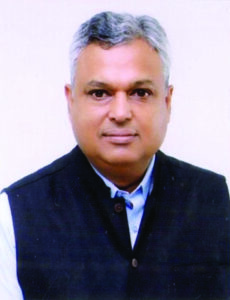In an exclusive interview, Dr. Saurabh Garg, secretary of the Ministry of Statistics and Programme  Implementation, speaks with Smart Governance editor J.P. Gupta about the ministry’s sweeping digital transformation, the integration of emerging technologies, and its vision for building a citizen-centric statistical ecosystem. He outlines how the ministry is aligning its efforts with the national priorities of Viksit Bharat and Vision 2047.
Implementation, speaks with Smart Governance editor J.P. Gupta about the ministry’s sweeping digital transformation, the integration of emerging technologies, and its vision for building a citizen-centric statistical ecosystem. He outlines how the ministry is aligning its efforts with the national priorities of Viksit Bharat and Vision 2047.
What are some recent digital initiatives undertaken by MoSPI to improve data collection and analysis?
The Ministry of Statistics and Programme Implementation (MoSPI) has fully transitioned from traditional pen-and-paper data collection to a digital mode using tablets through Computer Assisted Personal Interviewing (CAPI) in the National Sample Surveys (NSS). CAPI includes built-in data validation, online and offline functionality, and advanced features for managing and finalizing data faster and more accurately.
We have also developed in-house software for key processes like data validation, multiplier calculation, table generation, and Relative Standard Error (RSE) estimation. Additionally, AI/ML-enabled chatbot features have been integrated into select surveys, such as the All-India Survey on Unincorporated Sector Enterprises (ASUSE) and the Capital Expenditure (CAPEX) survey, to assist respondents and improve the data collection experience.
Thanks to these innovations, the time required to release survey results has significantly reduced. For example, the Comprehensive Modular Survey: Telecom (CMS:T) was conducted between January and March 2025, and the results were released by May—within just two months.
How is MoSPI leveraging AI, big data, and geospatial tools to modernize India’s statistical systems?
We have begun integrating AI/ML-enabled chatbots into surveys like ASUSE and the CAPEX survey. For instance, in the CAPEX web portal, an AI-powered chatbot, developed using Natural Language Processing (NLP), supports enterprises in self-compiling their responses by providing real-time guidance.
The Urban Frame Survey is being conducted digitally using advanced Geo-ICT tools through the Bhuvan platform. To further drive innovation, we launched a Data Innovation (DI) Lab in July 2024 to collaborate with academia, research institutions, and startups.
Recently, we initiated pilot projects for an AI tool to rejuvenate legacy data and an AI-based chatbot for intelligent document search. We’re also exploring future use cases such as:
An AI/ML-based classification tool for National Industrial Classification (NIC) codes
A Vision-Language Model to optimize resource deployment in Urban Frame Surveys (being piloted with IIT Madras)
We’ve also published a working paper on institutional readiness for emerging technologies and shared it across ministries. This year, India became a member of the UN Committee of Experts on Big Data and Data Science for Official Statistics (UNCEBD), marking our commitment to global leadership in this space.
How is MoSPI ensuring that real-time and granular data is available to support targeted policymaking under the Viksit Bharat vision?
MoSPI has enhanced the timeliness and frequency of its data releases. We now provide monthly estimates for indicators like Labour Force Participation Rate (LFPR) and Worker Population Ratio (WPR) through the Periodic Labour Force Survey (PLFS). The ASUSE, which was once a five-yearly survey, is now conducted annually, and we are working toward quarterly releases.
To improve data granularity, we’ve revised our sampling design so that States and UTs can generate district-level estimates, replacing the earlier state-level focus.
We also introduced an advanced annual release calendar to bring greater transparency. In 2024, we rationalized GDP release schedules by removing the Third Revised Estimates and moved the release timing for GDP and CPI from 5:30 PM to 4:00 PM, giving users more time for analysis.
Our timelines are globally competitive—CPI is now released within 12 days of the reference month, and IIP within 28 days (starting April 2025). These changes reflect our commitment to data-driven governance.
Looking ahead:
- The All India Survey of Service Sector Enterprises (ASSSE) will start in January 2026
- The CAPEX Survey, launched in 2024, will be conducted annually
- A Technical Expert Group (TEG) is guiding the upcoming All-India Income Distribution Survey, planned for 2026
- All survey outputs are released through our website, including anonymized microdata, metadata, and visualizations available on the e-Sankhyiki portal.
With platforms like e-Sankhyiki and automated surveys, how is MoSPI addressing challenges related to data quality, privacy, and inclusivity—especially across rural and urban regions?
CAPI is a three-tier system involving Enumerators, Field Supervisors, and Data Supervisors. It allows data to be collected online or offline and includes refer-back mechanisms to resolve inconsistencies. Real-time monitoring is enabled through dashboards integrated into the digital platform.
Our in-house software further strengthens backend functions like data validation, multiplier calculation, table generation, and RSE estimation.
On the privacy front, we follow a layered data access framework. Under the Statistical Data Dissemination Policy (2019), no datasets containing identification details of individuals or establishments are released. Before public dissemination, all microdata is fully anonymized—including the suppression of personal and locational identifiers.
The e-Sankhyiki portal serves as our main platform for data visualization and customized access, ensuring inclusivity by offering accessible tools for all users, from researchers to the general public.
What key reforms or innovations is MoSPI prioritizing to build a globally benchmarked, citizen-centric statistical ecosystem by 2047?
We are committed to building a citizen-centric statistical ecosystem that is transparent, responsive, and easy to use. Key priorities include:
Promoting data accessibility and usability through intuitive platforms like e-Sankhyiki, which now hosts over 135 million records and offers API access
- Publishing Annual Release Calendars to enhance predictability
- Revamping the microdata portal for easy access to anonymized datasets
- Launching a mobile app on Statistics Day 2025 for access on the go
- Providing a dedicated visualization section for clearer insights
To improve discoverability, we have developed a National Metadata Structure (NMDS), now shared with other Ministries/Departments. For quality, we’ve built a Statistical Quality Assessment Framework (SQAF) based on the UN’s National Quality Assurance Framework.
We’re also deepening engagement with stakeholders through data user conferences and feedback consultations. Efforts to improve statistical literacy are ongoing, supported by expanded media outreach, including through social media.
India is actively participating in global forums like the UN Statistical Commission, contributing to international standard-setting. We’ve also made our data dissemination faster—annual survey reports are now released within 90 days, and quarterly surveys within 45 days of completion.
Lastly, MoSPI now regularly publishes working papers offering data-driven policy suggestions to various ministries, helping enhance the effectiveness of government programmes.
Implementation, speaks with Smart Governance editor J.P. Gupta about the ministry’s sweeping digital transformation, the integration of emerging technologies, and its vision for building a citizen-centric statistical ecosystem. He outlines how the ministry is aligning its efforts with the national priorities of Viksit Bharat and Vision 2047.

















